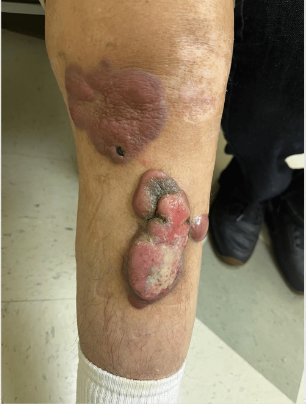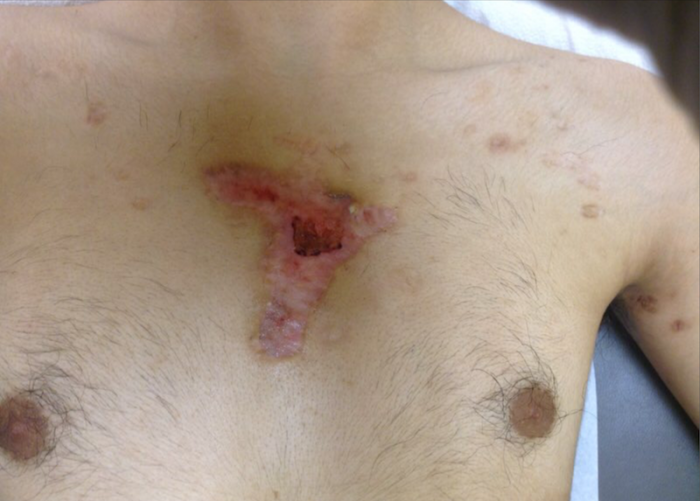CORRECT DIAGNOSIS:
Diffuse Large B-Cell Lymphoma – Leg Type
DISCUSSION:
Diffuse Large B-Cell Lymphoma (DLBCL) is a mature neoplasm characterized by the proliferation of large B-lymphoid cells and represents the most common subtype of non-Hodgkin lymphoma (NHL), exhibiting a range of clinical presentations. Among its various forms, DLBCL leg type is notable for its aggressive nature and distinct clinical characteristics. The median age at diagnosis for DLBCL is 64 years, with a slight female predominance. While primary cutaneous B-cell lymphomas exist, they are less frequent compared to cutaneous T-cell lymphomas. DLBCL leg type, though uncommon, poses significant diagnostic and therapeutic challenges, often presenting with solitary or clustered erythematous to red-brown lesions primarily affecting the distal aspects of the legs. These lesions can become ulcerated, leading to complications and increased morbidity.
The prognosis for leg type DLBCL is concerning, with a 5-year survival rate of approximately 50%, which is lower than that for other DLBCL variants. Its pathogenesis remains largely unknown, but it has been observed in immunosuppressed patients, highlighting the need for careful monitoring in at-risk populations. Diagnosis and staging involve a comprehensive approach, including thorough lymph node examination for involvement and evaluation for B symptoms such as fever, night sweats, and weight loss. Palpation of the abdomen is essential for detecting hepatosplenomegaly, and a detailed medical history regarding prior organ transplants or immunosuppression is crucial.
Laboratory studies typically include a complete blood count, metabolic panel, lactate dehydrogenase, and serologies for HIV and Hepatitis, alongside flow cytometry of peripheral blood. Imaging studies like CT and PET scans are integral for assessing disease extent, and a bone marrow biopsy may be performed to evaluate for bone marrow involvement. Histologically, DLBCL is characterized by large round cells, particularly centroblasts and immunoblasts, often positive for markers such as BCL-2, MUM-1, and FOX-P1.
TREATMENT:
Treatment for DLBCL leg type typically necessitates referral to a hematologist-oncologist, and our patient was referred to Texas Oncology for specialized care. The standard therapeutic approach involves chemotherapy, specifically the R-CHOP regimen, which includes cyclophosphamide, doxorubicin, vincristine, and prednisone combined with rituximab, administered every 21 days. Radiation therapy may also be considered based on disease stage and the patient’s overall health. In some cases, surgical intervention might be required, particularly for localized disease or to manage complications from ulcerated lesions. For patients with significant comorbidities, treatment may be adjusted to include rituximab alone or in combination with local radiotherapy.
CONCLUSION:
DLBCL leg type is an uncommon but aggressive lymphoma variant that presents significant diagnostic and therapeutic challenges. Its clinical features, along with a relatively poor prognosis, highlight the importance of early detection and tailored treatment strategies. A multidisciplinary approach involving hematology, oncology, and supportive care is essential for optimizing patient outcomes. Continued research into the pathogenesis and effective management of this subtype is crucial for improving survival rates and quality of life for affected individuals. Regular follow-up care is vital to monitor for potential recurrence and manage any complications arising from the disease or its treatment.
REFERENCES:
Padala SA., & Kallam A. Diffuse Large B-Cell Lymphoma. StatPearls [Internet]. Treasure Island (FL): StatPearls Publishing. 2023 Apr. [PMID 32491728]
Jaffe, ES., & Pittaluga, S. Aggressive B-cell lymphomas: a review of new and old entities in the WHO classification. Hematology. American Society of Hematology. Education Program. 2011 Jan; 506–514. [PMID 22160082]
Alexandra CH. Primary Cutaneous Diffuse Large B-Cell Lymphoma, Leg Type: Diagnostic Considerations. Archives of Pathology & Laboratory Medicine. 2012 Aug; 136(8): 876–881. [PMID 22849734]
Vodicka, P., Klener, P., & Trneny, M. Diffuse Large B-Cell Lymphoma (DLBCL): Early Patient Management and Emerging Treatment Options. OncoTargets and Therapy. 2022 Dec; 15:1481–1501. [PMID 36510607]
Harris, N. L., Jaffe, E. S., Stein, H., & Vardiman, J. W. (2016). WHO Classification of Tumours of Haematopoietic and Lymphoid Tissues (4th ed.). Lyon, France: International Agency for Research on Cancer. [PMID: 27552566]
Cataño, J. J., & Ríos, E. (2021). Cutaneous manifestations of diffuse large B-cell lymphoma: A clinical and histopathological review. Actas Dermo-Sifiliográficas, 112(5), 410-417. [PMID: 33562219]
Dybkaer, K., & Bøgsted, M. (2017). Treatment of diffuse large B-cell lymphoma: Current options and future perspectives. Journal of Hematology & Oncology, 10(1), 1-15. [PMID: 28659250]




